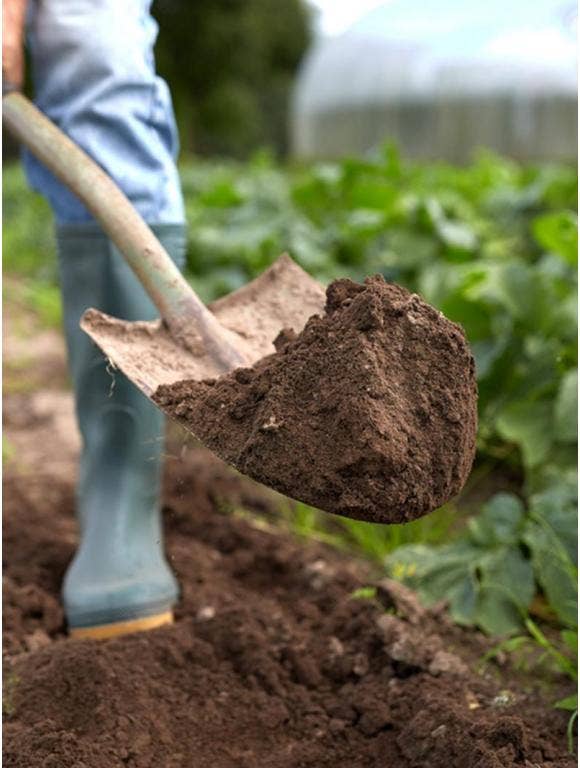
Soil. We trample it. We strip it. We neglect it. We even call it names, like dirt! We depend on soil — and not just for gardening but also for all kinds of farming, including the kind that keeps our refrigerators, freezers and pantries stocked.
A lot of gardeners already know the drill on soil: When it's good, so is the garden. But it's important to know how to refresh garden soil, to give plants as hospitable a home as possible.
The best soil for most plants is a moist, well-drained loamy soil, which is the perfect balance of sand, silt and clay. But even a loamy soil can start to suffer. Plants eventually use up nutrients and unless new organic matter is introduced, there's not much to feed earthworms or beneficial microbes. Here's how to amend garden soil in fall to encourage your garden's bounty the next season. Learn more with Burpee's Garden Guide.
Add Compost
Compost is the best organic matter you can introduce to soil — and that goes for any soil, from clay to sand. A soil with too much clay drains poorly because the fine soil particles stick together and make it harder for air to reach plant roots. Compost breaks up that sticky mass. Compost also helps sandy soil hold water and nutrients that would otherwise quickly leach out of the porous soil. To add compost to your garden, work it into the top 2 to 3 inches of your garden bed.
Add Leaves
To learn how to refresh garden soil, take a page from nature's handbook and add organic matter. That's what nature does every fall when leaves drop. Trouble is, most of us rake up this bounty and put it out on the curb.
Instead, bag leaves to keep on hand to add to your compost pile. Carbon-rich leaves balance the nitrogen-heavy kitchen scraps for quicker composting. You can also shred leaves with a chipper, shredder or a mulching lawnmower and spread the remains in the garden. These shredded leaves break down faster — and they're less likely to blow away in the wind.
Or try digging leaves into the vegetable garden in the fall. Some leaves are better suited for this than others. Silver maple leaves will practically disappear by late spring, while more rigid oak leaves tend to disintegrate slowly. Use oak leaves as a mulch, because they'll hold up till the following summer when mulch is most needed. Just be sure to shred them up first, as whole leaves can form a mat that water can't penetrate. (And never use walnut leaves, which contain a substance called juglone that can kill or damage plants.)
By spreading leaves in your flowerbeds in the fall, you can give butterfly eggs or larvae a place to wait out the winter, ensuring new generations. Plus, spreading the leaves after the ground has frozen can prevent frost-heaving of perennials in winter while slowly breaking down and feeding the soil.
The Ruth Stout Method
Another way to refresh the soil is the Ruth Stout Method, named after a popular garden writer who wrote a series of books about no-till gardening half a century ago. Stout "mulched in place," which is to say she piled straw, leaves, garden debris and other organic materials around her vegetables and let nature take its course.
Using the Ruth Stout Method in vegetable beds and in natural shrub borders is convenient because you don't have to bag clippings or leaves, turn a compost pile, till the soil or weed the beds. Plants need less watering, and there are earthworms galore doing what they do best: aerating the soil and fertilizing with their castings. However, if you encountered any diseased plants in your garden, you will need to remove them and this method wouldn't be as suitable in that case.
Test Soil pH
While the above methods will gradually improve soil, it pays to test your soil so you have a better idea of what you're working with. A soil test kit can tell you the soil pH (which is the measure of acidity versus alkalinity) and whether the soil needs one or more of the three primary macronutrients (nitrogen, phosphorus and potassium). Soil pH is important for several reasons. Most plants prefer a neutral to slightly acidic soil (a pH of 5.5 to 7.0), so higher or lower levels will appeal to fewer plants. Also, certain nutrients are unavailable to plants at higher or lower pH levels, so they end up looking pale and sickly.
Once you know the soil pH, you can change it, if needed. Add garden sulfur to lower pH or garden lime to make soil more alkaline. The amount you need to add will depend on the type of soil; follow the directions on the package.
Tilling Soil
Along with organic matter, nutrients and pH, another factor that can affect soil health is compaction. It's especially noticeable on clay soils that have been trampled when wet. This damages the soil structure and makes it harder for moisture, nutrients and air to reach plant roots.
Tilling can help if it's done infrequently — not season after season, which can result in a powdery soil that crusts over and repels water. Tilling can be hard work, so there's no shame in calling in a rototiller to help in the process. Another option is double digging. Remove a row of soil, digging about 1 foot deep and reserving the excavated soil. Use a spading fork to loosen the hardpan (a dense subsoil lighter in color than the topsoil you just removed) before moving on to the next row. Again, dig down 1 foot, this time placing the excavated soil into the first trench. Loosen the subsoil of the second row, then proceed to the third row. Repeat the process until you reach the end of the bed and fill the final trench with the reserved soil.
In the end, the easiest thing to do might be to construct raised beds and fill with a 1:1 mix of good garden soil and compost. Raised beds have several benefits: You never step in them, so the soil doesn't become compacted. Plus, the beds can be worked earlier in spring than in-ground garden beds. And finally, you can create whatever kind of mix you like — no need to make wholesale changes to an in-ground bed.
Burpee has everything you need to refresh your soil, from fertilizers to organic matter to loosen up tightly packed garden beds.




